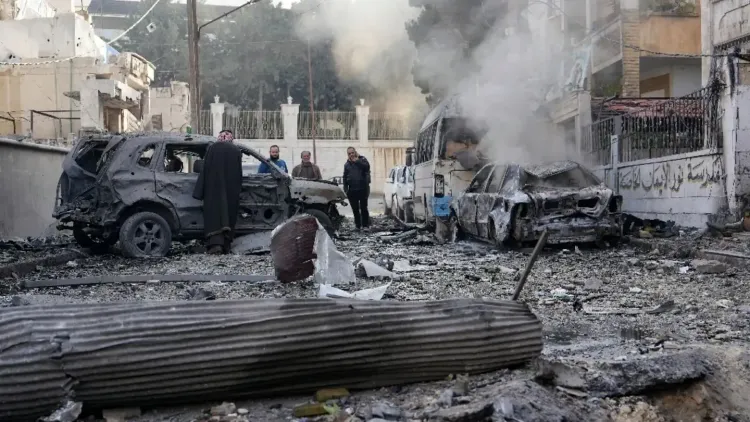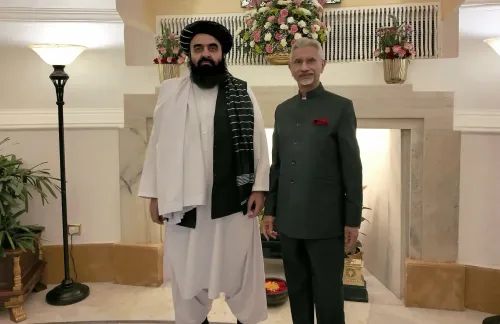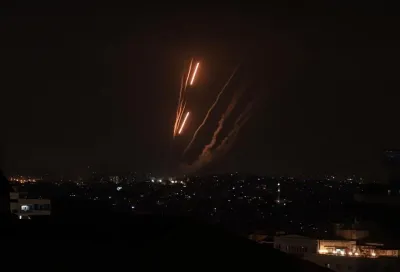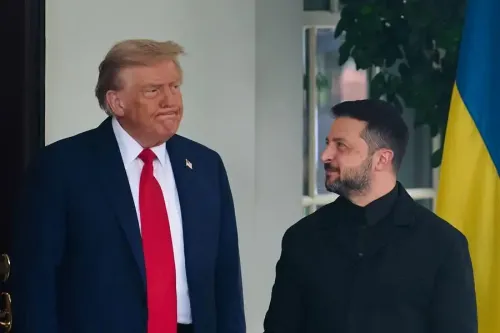The Third Eye: Syria Acknowledges the Surge of Extremism in West Asia

New Delhi: The takeover of Damascus by radical Islamic factions, which forced Syrian President Bashar Al-Assad to seek political asylum in Moscow on December 8, was perceived as an abrupt turn of events. However, it symbolized the culmination of developments that had been unfolding in Syria and Iraq over the years, reflecting the profound impact of religion on longstanding superpower rivalries in the region, which were concurrently reshaping global geopolitics.
Historically, in 1928, a Muslim intellectual named Hasan Al Banna established the Ikhwanul Musalmeen or Muslim Brotherhood in Egypt and Syria to challenge the regimes of Gamal Abdul Nasser and Hafez Al-Assad—the father of Bashar Al-Assad—who were viewed as pro-Soviet 'nationalist' Arab leaders.
Banna posited that the Quran embodied the ultimate Constitution for Muslims and that an Islamic state could coexist 'in competition, not conflict with the West.' The US-led West recognized the significance of the Muslim Brotherhood movement and even lent it support.
In 1940, Maulana Abul Ala Maudoodi, inspired by Hasan Al Banna, initiated Jamaat-e-Islami in Lahore, extending this pro-West Islamic ideology to the Indian subcontinent, laying the groundwork for the Nizam-e-Mustafa, a vision defined by President Zia-ul-Haq for Pakistan.
The Soviet invasion of Afghanistan in 1979 and the Iranian Revolution of 1978 ignited a wave of Pan-Islamism throughout the 1980s, which received backing from the Saudi-led Organisation of Islamic Conference (OIC).
During the fourth Islamic Summit in Casa Blanca in 1984, Zia-ul-Haq proclaimed that Muslims from 'Morocco to the Philippines' constituted one community that needed to unite in addressing shared challenges.
The Pan-Islamism movement aimed to combat the influence of Communism, enjoying the endorsement of the United States, whose closest ally in the Muslim world, Saudi Arabia, was spearheading this initiative. Yet, a much older sentiment of anti-Western sentiment existed in the Muslim world, rooted in the historical context of the 'Wahhabi Revolt', a jihad led by prominent scholars in the 19th century against Western encroachment on Muslim territories.
Events in Afghanistan post-Soviet invasion paved the way for radical fundamentalists to gain influence in the region, which would later affect the trajectory of conflicts in the tumultuous Middle East.
The anti-Soviet armed resistance in Afghanistan was facilitated by the CIA and Pakistan's ISI, championing the cause of jihad, which involved not just Pakistan-supported militant groups and Saudi-funded Lashkar-e-Toiba (LeT), but also radical factions led by Al Qaeda and Osama bin Laden.
The withdrawal of Soviet forces from Afghanistan in 1991 led to the disintegration of the USSR and the decline of International Communism, while plunging Afghanistan into chaos due to warlord rivalries—chiefly between General Ahmad Shah Masood and Gulbuddin Hekmatyar, the latter backed by the US and Pakistan.
In 1993, Benazir Bhutto, then Prime Minister of Pakistan, dispatched the Taliban—products of Deobandi madrasas known for their strict fundamentalism—to Afghanistan, where they established the Taliban Emirate in 1996 under Mullah Mohammad Omar, a close associate of Osama bin Laden.
The Taliban carried the historical legacy of the Wahhabi movement, as the Darul Uloom Deoband was founded near Saharanpur in India in 1867 by proponents of a failed anti-British jihad. The Emirate soon turned its hostility towards the US, leading to a concerted effort to dismantle the Emirate by 2001.
Such events set the stage for the 9/11 attacks, orchestrated by Osama bin Laden while residing in Afghanistan. The subsequent 'war on terror' initiated by the US-led Coalition against Islamic radical factions first in Afghanistan and later in Iraq resulted in significant global repercussions and, predictably, contributed to the spread of 'radicalisation' in both regions.
Al Qaeda maintained a presence in Afghanistan, while a competing entity, the Islamic State of Iraq and Levant (ISIL), later termed ISIS, emerged in the Iraq-Syria area. Bashar Al Assad inherited his father's legacy of animosity towards the US, which allowed him to secure support from Russia.
Additionally, Assad's identity as an Alawite—a sect of Shia Islam—garnered backing from Iran and Hezbollah on religious grounds, despite the pre-existing political friction between Iran and the US. The Assad regime's facilitation of Shia dominance in key positions, neglecting the Sunni majority, exacerbated radicalisation among disenfranchised Sunni groups.
Syria descended into a civil war due to the Assad regime's oppressive policies amidst economic hardship faced by the populace, while concurrently confronting radical Islamic forces from both Al Qaeda and ISIS, as well as pro-Western Islamic factions.
Current developments in Syria should be contextualized within the backdrop of the Arab Spring of 2011, a democratic movement challenging dictatorial Arab regimes.
In Egypt, the Muslim Brotherhood took the lead, a situation that initially aligned with US interests. However, as the unrest spread throughout the Arab world, it created an opening for radical forces, leading to Western support for ruling regimes becoming contingent on their alignment with US foreign policy.
Generally, Muslim societies revert to their faith during times of crisis. While this is true across various cultures, they are often more susceptible to fundamentalist ideologies or calls for jihad due to the 'pull of exclusivism' inherent in faith during such circumstances. Proponents of faith-based militancy effectively utilized social media for indoctrination, transforming radicalisation into a potent source of global terror threats.
Radical Islam occupies a distinct space within the broader spectrum of faith and cannot be entirely dismissed by Muslim communities.
The conflict in the Middle East encompasses both political and religious dimensions, with the US, Israel, and Saudi Arabia generally aligning against the Russia-China-Iran coalition, as fundamentalist Shia ideologies fundamentally oppose capitalism.
An anti-Assad alliance consisting of Qatar, Turkey, and Saudi Arabia has also played a significant role in regional politics.
Radicalised Hamas has found common ground with Iran, given both factions' anti-US stance. The ongoing confrontation between Iran and Israel reflects, to some extent, the historical struggle between Zionism and Islam.
The recent attack by ISIS-K on a concert in Moscow, resulting in the deaths of at least 130 individuals, was largely viewed as retaliation against prior Russian missile strikes on ISIS targets in Syria and Iraq.
For ISIS, both the US and Russia represent threats, given their perceived encroachment on Muslim lands.
The US-led West and the China-Russia alliance vie for a competitive stake in West Asia for political and economic motives.
The US has actively countered its primary adversaries—Al Qaeda and ISIS—by targeting their leadership through intelligence-driven operations.
In May 2011, Osama bin Laden was killed during a military operation in Abbottabad, near Islamabad, while his successor, Ayman al Zawahiri, was eliminated in a drone strike in Afghanistan in 2022.
Interestingly, the current leader of Al Qaeda, Saif Al Adel, is believed to be operating out of Iran. ISIS originated as an offshoot of Al Qaeda, established by Abu Bakr Al Baghdadi, the leader of Al Qaeda in Iraq (AQI), in 2013 to function in Iraq and Syria.
Nusrat Front, another Al Qaeda affiliate in Syria, continues to operate independently. Its leader, Abu Mohammad Al Julani, has rebranded Nusrat Front as Hayat Tahrir Al Sham and has emerged as a significant power broker in Damascus following Bashar Al Assad's departure.
Al Julani has also maintained connections with the Islamic State. It should be noted that in Iraq, the US conducted airstrikes to stave off ISIL's expansion into northern regions, aiming to protect Christians and Yazidis—groups that adhere to both the Quran and the Bible. The US also released footage showcasing ISIL fighters executing Western aid workers and journalists.
In 2019, Baghdadi was killed in a US raid in Syria, during which he detonated his suicide vest.
After Baghdadi's death, ISIS-K—with the 'K' representing Khorasan—emerged as the primary face of the parent organization.
Khorasan refers to the region encompassing Afghanistan, Persia, and Turkmenistan. The overall situation in the Iraq-Syria region was marred by sectarian violence. Such conflicts tend to be perpetual and unresolved.
From an Indian perspective, maintaining diplomatic relations with major powers in the Middle East—namely Iran, Saudi Arabia, and Israel—while advocating for global peace and human development remains a challenge.
Signs indicate a new Cold War between the US and the China-Russia alliance, and in this context, India's strategy should focus on remaining 'independent' while promoting the cessation of armed conflicts and the initiation of peace negotiations.
India has successfully navigated this approach regarding both the Ukraine-Russia conflict and Israel's military operations in Gaza.
India swiftly condemned the Hamas terror attack on Israel on October 7 last year.
This country must firmly oppose faith-based violence and consistently call for the condemnation of terrorism in all its manifestations through various multilateral platforms, including BRICS, Quad, and G20.
India's challenges concerning radicalization are closely tied to Pakistan's dubious role, as it has managed to align itself with the US despite its established history of harboring Islamic extremist groups and utilizing terrorism as a state policy tool.
Al Qaeda in the Indian Subcontinent (AQIS) operates from Pakistan, and elements of ISIS-K have reportedly been sighted in Kashmir.
The Sino-Pakistan alliance is believed to be collaborating on covert operations against India.
There have been multiple reports of Chinese drones being used to drop arms and narcotics in Kashmir and Punjab, with both hostile neighbors also coordinating anti-India cyber operations.
The ongoing turbulence in West Asia, particularly in Syria and Gaza, serves as a reminder for India to closely monitor developments in the Islamic world and their implications for national security.
(The writer is a former Director of the Intelligence Bureau. Views are personal)









